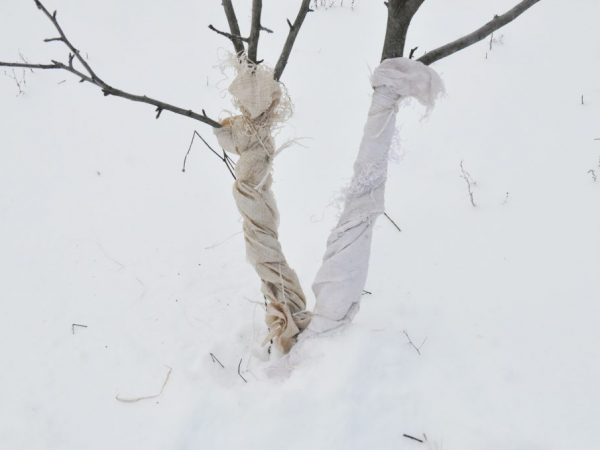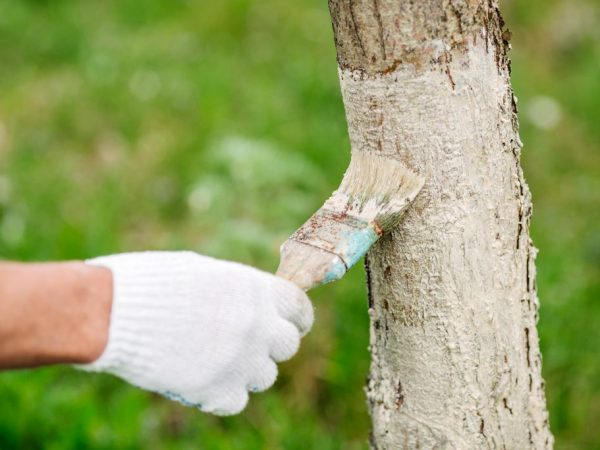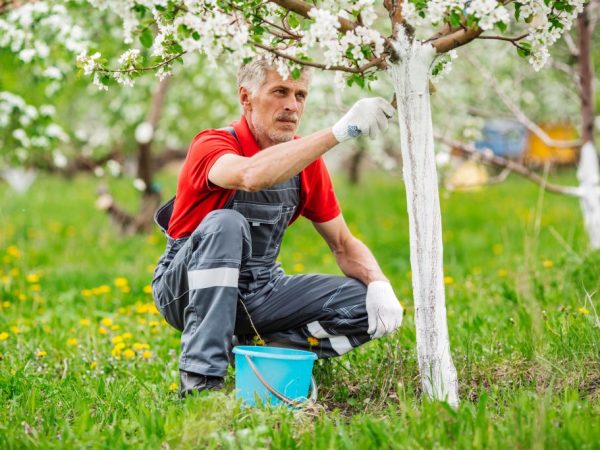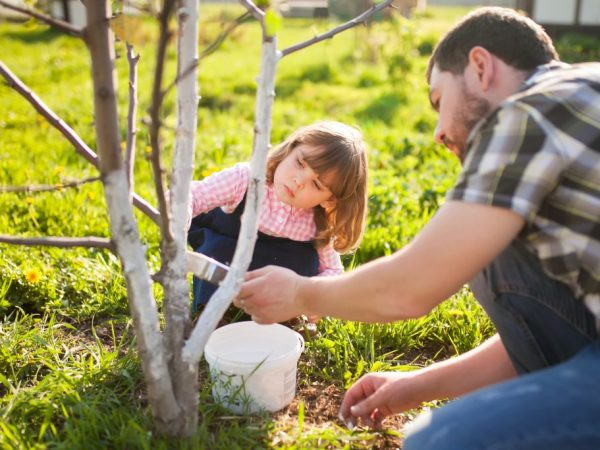Rules for protecting an apple tree from rodents
The protection of the apple tree from rodents should be carried out annually - this will help preserve the harvest and increase the life of the crop.
- How to protect an apple tree
- Chemicals
- Using a covering material
- Mechanical protection
- The principle of barrel winding
- Features of barrel coating
- Scaring away rodents with smells
- Ultrasonic deterrent
- Using folk remedies
- Prohibited actions
- Rescue a damaged tree
- Medical dressings
- Graft
- Bark engraftment
- Back-cut trunk
- Conclusion

Rules for protecting an apple tree from rodents
Ignoring this process will lead to the fact that pests will harm the fruit and the tree itself. Chances are good that it will no longer bear fruit.
How to protect an apple tree
If mice appear in your garden, urgent measures must be taken before they nibble on the apple tree or other fruit trees.
There are many methods you can use to do this. You just need to choose from this list the most suitable one for you.
Chemicals
Often, gardeners prefer to use chemicals that repel pests from the apple tree.
The most common are copper sulfate and water emulsion solution.
Copper sulfate
With the help of copper sulfate, you need to process the tree in the fall, when there are no leaves left on it.
It takes a little longer to prepare a special chemical solution than in the case of other substances. First, you need to extinguish 1 kg of lime and dissolve the resulting composition in 6 liters of warm water.
After that, add 200 g of copper sulfate to the mixture and let it brew for 2-3 hours. After that, you can safely spray the bark.
Advice! Remember that such a chemical is considered very dangerous to humans, so protect your skin with thick clothing and respiratory tract with respirators.
It is customary to use copper sulfate when feeding cultivated plants (pears, apples and grapes). Treatment with this substance will not only protect the tree from pests, but also feed the weakened plant.
Water emulsion
Often from hares and mice that eat the bark of an apple tree, they are treated with a water emulsion.
This substance creates a weightless film on the surface of the tree - it also repels pests.
For maximum protection of the apple tree from rodents, Bordeaux liquid is added to the water emulsion (proportions 1: 1).
Both chemicals are diluted in separate buckets, infused for a couple of hours and only then mixed. Treatment with water emulsion should be carried out at the time of the onset of frost.
Poison
Pesticides are also often used, which lead to the death of rodents.
Most gardeners refuse such drastic actions, because pets that enter the garden can also die from such treatments.

Choosing the right solution for rodent protection
If you have already decided to poison pests, then use the following substances:
- poisons that are used to neutralize rats;
- balls of bread, to which the seeds of the crocus are added;
- gypsum baits, which are mixed with flour and sunflower oil as bait.
In the evening, place such preparations near burrows where hares, mice, or other pests live.
To save pets, in the morning you need to collect all the baits and burn them away from the garden.
If after a while all the baits remain in place, it means that you managed to destroy all the mice and hares. Now fill the hole with cement to prevent other pests from breaking into your garden.
Using a covering material
The use of a covering material helps to protect the apple tree not only from rodents, but also from a negative climate.
The most common is polyethylene. They need to cover the trunk in about 6-7 layers.
Such manipulations are carried out when the frost period begins. As soon as it gets warmer outside, the covering material is removed so that there is no greenhouse effect inside. In the presence of cloudy weather or rain, it is also removed.
Mechanical protection
Mechanical methods are used to effectively protect the apple tree from rodents. They consist in the use of metal nets or roofing material - it will be difficult for rodents to get to the trunk.
Use only a fine mesh, the height of which is at least 5 m.For the stability of the structure, it is dropped around the trunk by 30 cm.To scare away pests from the apple tree, leave about 15 cm between the mesh and the trunk and fill the voids with coniferous branches.
Hares and mice cannot stand the smell of pine needles categorically.
The next option is to use roofing material. A sheet is wrapped around the entire trunk and tied with strong threads or ropes. This method protects the bark not only from rodents, but also from other mechanical damage.
The principle of barrel winding
Spruce branches are often used to protect the apple tree from frost and vermin. The spruce needles should be located at the bottom of the tree. Several layers of polyethylene film are wound on top. To keep the covering material stronger, a mound of earth is made around the trunk.
If there are signs of pests, wrap the trunk with thick paper according to the same principle as roofing material. Layer the paper 8 times to prevent the parasites from biting through it.
Some summer residents prefer to use the budget option: they wrap the tree bark with nylon tights to a height of 1-1.5 m.
Nonwovens are also used - they are much cheaper.
The winding is carried out in a spiral manner to protect the garden from temperature changes.
Features of barrel coating

We save the trunk from pests
Apple tree coating is a common method of protecting apple trees from rodents.
First option
A mixture of clay and mullein is used in equal proportions. Pour the ingredients with warm water so that the consistency of sour cream is obtained.
For a more pronounced effect, add 1 tbsp to the prepared mixture. l. urea.
The resulting liquid is coated on the trunk of the apple tree.
Second option
The coating is also carried out using a special whitewash paint.
For 1 tree, at least 50 g of paint will be required (for a middle-aged, but fruitful tree, 3 times more material will be required).
The coating is carried out using a paint brush or spray gun. The paint is given 1 hour to dry and create a protective layer on the surface of the barrel.
The third option
Spraying is also carried out using copper sulfate or Bordeaux liquid.
Copper sulfate (10 g per 10 l of water) is sprayed in November, when the first frosts appear. About 3 liters of solution is sprayed onto a young plant, and for an adult, about 20 liters will be needed.
For spraying with Bordeaux liquid, you will need 100 g of substance per 10 liters of water. Processing is carried out in October and 5 liters are used for a young plant, and 15 liters for an adult.
Scaring away rodents with smells
Rodents are believed to be unable to tolerate the aromas of fresh lard, blood, or naphthalene. So that they do not overeat the culture, you need to coat the apple trees in your garden with the listed available means.
An adult plant will require about 1.5 kg of fat, 3 liters of blood (take from a pig or beef) or 200 g of naphthalene. For young seedlings, 3 times less substances will be required.
You can lay out sawdust soaked in lysol around the trunk - the smell will scare away rodents.
To prepare a fragrant mixture, 30 g of lysol and 8 liters of water are required.
After that, the sawdust is poured with this solution and spread around the trunk. You will have to repeat this procedure at least 3 times during the winter, since fragrances tend to erode.
Ultrasonic deterrent
Ultrasound is effective as a defense, but not practical. In winter, due to low temperatures, the device is often discharged.
To prevent pests from gnawing on the bark, you will have to either constantly change the batteries in it, or connect it to an uninterruptible power source.
Remember that the actuation distance is short. Ultrasound is unable to penetrate walls, concrete or other types of fences.
Using folk remedies
There are folk remedies that are much cheaper than other methods of protection, but no less effective.
Rats and mice do not tolerate the smell of mint, so the branches of this plant are tied around the trunk or essential mint oil is added to the mixture intended for spraying or coating.
In addition to mint, these properties are inherent in wild rosemary and elderberry.
Some rodents move under the snow if the snowdrifts are high. The elementary trampling of snow around the tree will help protect the apple tree from these pests.
Prohibited actions

We follow all the recommendations for protecting the tree
There are also certain prohibitions when protecting an apple tree from field mice and hares.
Do not use organic substances during coating or wrapping. Especially straw and humus.
The bottom line is that rodents are bred in organic products. If you process a crop with them, then you will only create an ideal habitat for pests.
Rescue a damaged tree
Medical dressings
Linden broth
For cooking, you need 50 g of linden bark and 2 liters of water. Insist on such a substance for a day, after which tissue dressings are impregnated with it.
They wrap the affected areas and cover them with a thick layer of paper.
The procedure is repeated all winter, every month. Usually, after 2-3 months, the plant recovers.
Clay talker
Cover half of the 10-liter bucket with clay. It is poured with warm water 3 cm higher.
The mixture is infused for 2-3 hours, after which the affected areas of the tree are treated with it.
Rescue will be faster if you cover the clay mixture with a cotton cloth.
Graft
If the pests gnawed the bark, then wound grafting helps to heal the apple tree.
It is carried out at the end of March before the juice from the trunk appears.
- The entire damaged part of the tree is removed, affecting a small amount of healthy tissue.
- Last year's cuttings, up to 7 cm in length, are sharpened from 2 sides. To do this, use a scythe or a sharp knife.
- The formed branches need to be stuck in the place where the damaged tissue was (top and bottom). Depending on the thickness of the apple tree, the number of cuttings may vary.
- The formed bridge is wrapped in polyethylene, tied with a rope and treated with garden pitch.
As soon as the cuttings are accepted, they are used as a donor material (it performs the function of exchanging useful substances between roots and shoots).
After 2-3 years, the grafted shoots will merge together and become a component of the young crown.
There is another way of grafting a tree: planting a young wildling next to it. The upper part is sharpened and passed under the bark. It is advisable to vaccinate over the damaged area.
Bark engraftment
There is another method that helps to preserve a damaged apple tree: you need to engraft a part of a young and healthy bark. This process is complicated and not every gardener can do the procedure.
Process:
- take a small branch from the same tree;
- remove all the bark from it;
- insert in place of the damaged area (the size of the branch should exactly correspond to the place of damage), the direction should be equal to the movement of bark growth;
- the healing bark is glued to the damage with paper tape;
- Apply 8 liters of warm water and fertilizer under the apple tree every week.
Back-cut trunk
This method is used if the previous ones did not help.
In the process of cutting the trunk for reverse growth, the gardener must cut off the diseased trunk, reaching the lowest kidney.
The process must be carried out before the blooming begins. Do everything carefully so as not to hurt the kidney that remains.
So that the sore spot does not germinate, it is watered with garden varnish. With its help, you neutralize the action of bacteria and microbes, which only spread damage to healthy tissues.
Conclusion
Protecting and saving an apple tree from pests is a difficult process that will require effort and money from you.
It is important to notice the problem in time. If the mice have already gnawed on the bark, then there is little chance of saving the apple tree. We'll have to cut it down completely and plant a new tree.

